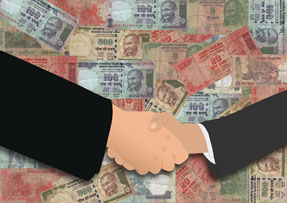Business
Capital Plight: What Drives Corruption In India?

Just 20% of people in India would be honest, regardless of the temptations, according to a former Central Vigilance Commissioner.
| November has been a nightmare month for some Indian politicians, businessmen and bureaucrats. The cauldron of corruption, which in India is always bubbling quietly in the background, suddenly erupted — not once, but several times.
The biggest recent scam — and the largest in Indian history—involves the $40 billion 2G (second generation) spectrum allotment. Union telecom minister A. Raja was forced to resign on Nov 14 as a result.
In the Western state of Maharashtra, Chief Minister Ashok Chavan was another casualty. The issue: a housing cooperative society called Adarsh which had set up an illegal multistoried building in downtown Mumbai. It was originally intended for war widows, but was eventually occupied by bureaucrats and the well-connected. The members included three of Chavan’s relatives. In Delhi, the continuing investigation into the Commonwealth Games (CWG) scam has seen three more arrests of members of the organizing committee. The net is spreading wider even as the CBI has been unearthing dozens of bank accounts and dubious deals. The chairman of the organizing committee, Suresh Kalmadi, has been forced to resign as secretary of the Congress Parliamentary Party.
In Bangalore, the rightist Bharatiya Janata Party (BJP) has been trying to rein in its chief minister, B.S. Yeddyurappa. Yeddyurappa stands accused of denotifying or changing the classification of land (in this case to commercially exploitable status) in favor of his family members. The $100 million scam was unearthed through the Right to Information Act. No one has denied the facts; the chief minister’s defense is that earlier chief ministers had done exactly the same thing. The case is now being actively followed by the Karnataka Lok Ayukta (ombudsman). No Longer an Issue “Corruption has ceased to be an issue in Indian politics since 1989,” says M.R. Venkatesh, whose just-published book Sense, Sensex and Sentiments: The Failure of India’s Financial Sentinels explores corruption in India in the financial arena. “The attitude today is: ‘Your scam is bigger than mine.’” (In 1989, V.P. Singh defeated Rajiv Gandhi in the general elections over the Bofors scandal—one of the biggest defense kickbacks, involving Swedish armaments manufacturer Bofors. Large payments were made but the recipients have never been traced.) If the November news was particularly eye-popping, it’s not as though this has been an otherwise barren year. In April, union minister of state for external affairs Shashi Tharoor resigned after his alleged involvement in facilitating the entry of a new team in the lucrative Indian Premier League (IPL). The IPL commissioner, Lalit Modi, was accused of corruption and sacked by the country’s cricketing authorities. And taking the action overseas, Swraj Paul and Amirali Alibhai Bhatia — both of Indian descent—were suspended from the House of Lords for falsifying expense statements. “Some things are in our blood,” says Venkatesh. While the most recent scandals were surfacing, Global Financial Integrity (GFI) in Washington published a report titled The Drivers and Dynamics of Illicit Financial Flows from India: 1948-2008. The report’s findings are that during this period, India lost a total of $213 billion dollars due to illicit flows, the present value of which is at least $462 billion. “The total value of illicit assets held abroad represents about 72% of the size of India’s underground economy which has been estimated at 50% of India’s GDP (or about $640 billion at end 2008),” says the report. Interestingly, the outflow of illicit funds has actually gone up in the post-liberalization period. What Drives Illicit Flows
But why have illicit flows—a measure of corruption—gone up post liberalization? Fewer controls should mean fewer bribes. And fewer curbs on foreign exchange (coupled with a steady rupee) should be incentive to keep money at home. Kar says that liberalization has produced greater income inequality. The number of high net-worth individuals (HNIs) has gone up. Capital exodus is caused primarily by private companies and HNIs. “This may explain why faster economic growth in the post-reform period has spurred more capital flight rather than less,” notes Kar. Other data reflect Kar’s view that corruption is on the rise. “India ranks poorly on the Transparency International (TI) Corruption Perceptions Index (CPI),” he says. “TI ranks India at 3.3 in 2010, lower than all developed countries and even some countries in Africa.” India was ranked 16 in the Asia-Pacific region and 87 overall. China (3.5) is one rank ahead in Asia while the leaders are New Zealand (9.3), Singapore (8.3) and Australia (8.7). There has been a decline in India’s showing over the years. Last year, it was ranked 84 (score 3.4); 85 (3.4) in 2008; and 72 (3.5) in 2007. The fact of corruption is undeniable. The direction in which it is going also seems clear. “Corruption has social acceptance,” says Pratyush Sinha, who recently retired as Central Vigilance Commissioner (CVC). Talking to daily newspaper Mint, he said: “There would be 20% of people in India even today who would be honest, regardless of the temptations, because this is how they are. They have a conscience, they would not be corrupt. There would be around 30% who would be utterly corrupt. But the rest are the people who are on the borderline.” The government has appointed P.J. Thomas as the new CVC. Ironically, at the end of November, the Supreme Court asked the government whether Thomas would be able to function in his new job as there were charges against him in the palm oil scam case in Kerala. No Social Penalties In the West, law enforcement is regarded as one of the least corrupt professions. In India, policemen come one step below politicians in such rankings. According to another TI report, 87% of the people in India regard the police as corrupt. What makes India and Indians so prone to corruption? Some give it a historical perspective. Corruption has been intrinsic to Indian society since the Mughal rule (1526-1757), particularly during its latter days. The word baksheesh was coined then and has passed into the English language now. Baksheesh (speed money) had to be paid to officials to get every small thing done. The concept—and acceptance—of a corrupt bureaucracy started from those days. Under British rule, the country was even more corrupt, experts point out: The man who is considered to have conquered India—Robert Clive—returned to England to face charges of corruption in Parliament. The first Governor General of India—Warren Hastings—had to face impeachment proceedings before the UK House of Commons. He was acquitted after seven years. Independent India inherited the same bureaucracy and has carried on in the same vein.
A “black money” culture also evolved over time. Taxation rates during both the Mughal and British periods were extortionate. There were taxes on land, on trees, on cattle, on marriage, etc. The Mughals had 40 different taxes. Both Mughal and British tax collectors (the zamindars) used to go to villages and impose tax on the appearance of prosperity. It was natural for people to hide their wealth. The combination of these factors and a shortage economy resulted in the phenomenon continuing. Post Independence, there have been other factors such as the License Raj, the growing criminalization of politics and the absence of any hard measures or speedy action. “The British did not encourage Indian industry,” says author Venkatesh. “So you had to take every advantage of the law to set up a company. But why go that far back? Post Independence it was the same thing. In a socialist economy, business was bad. The definitive Bollywood (Hindi cinema) image of those days was a poor villager taking on the big, evil monster—almost invariably a businessman. Corruption is part of our mental make-up.” There are many with little sympathy for such views. “This is true,” says Kar. “But how does that help us? At some point, we need to unburden ourselves of the past. I don’t think India’s poor will find solace even if we could trace the current state of political corruption in India to how things were under the Mughal Empire or the British Raj.” Adds Dipankar Gupta, former professor of sociology at the School of Social Sciences at Jawaharlal Nehru University: “I don’t see any point in tracing our corruption to Mughal and even British times. The context is most important in all such matters. I would advise a more contemporary reading of issues or else we can very easily lose the plot. Black money, too, has little to do with Mughal times. Similar instances can be found all over the world in the medieval and early modern period. Many European societies, Sweden included, were not the exemplars that they are now. Black money has to do with evasion of taxes, and taxes today are not the same as in the past when it was extortion and set around the whims of rulers and potentates.” One should learn from history, says Gowda of IIMB. “Corruption has certainly existed in India historically; Kautilya, in his Arthashastra, discusses how to combat it,” he notes. “It arises because individuals realize that they have an opportunity to divert resources due to the government, and some choose to try and get away with diverting funds. But it has always been combated as the examples of Clive and Warren Hastings suggest. Systems of oversight and professional values have also existed and these often induced people to stick to the straight and narrow, particularly in the bureaucracy before and after freedom. During the Gandhian era and for a generation after, simplicity and honesty were prized values. To succeed, the method of Satyagraha (non-violent resistance) required Indians to have superior moral standing compared to exploitative colonialists and this came in the way of corruption.” Drivers of Corruption “Corruption is universal in its origin and application. The word itself etymologically goes back to the French and the Latin. In essence, corruption connotes a deviation from socially accepted norms. The propensity for corruption is generally determined by three contributing conditions: First, the pressures for amassing wealth (or status or recognition); second, the opportunities for achieving such objectives (such as discretionary powers to grant favors or inflict punishments); and third, the scope for rationalization (such as ‘everyone does it’, ‘I deserve better but the establishment is not inclined to agree’ and so on). Virtually every category of corruption in public life can be traced to the existence of these criteria. There should also be concomitant weaknesses in the system which will delay or even deny detection of such frauds.” For Balasubramanian, as for many others, the exposure of the 2G and CWG scams are positive signals. “Unfortunately for the perpetrators, the countervailing control mechanisms did frustrate their objectives,” he says. Adds Gowda: “The way scams are exposed suggests that there are enough self-correcting features in the Indian system, even if they work in a less predictable manner. There is hope yet.” |




